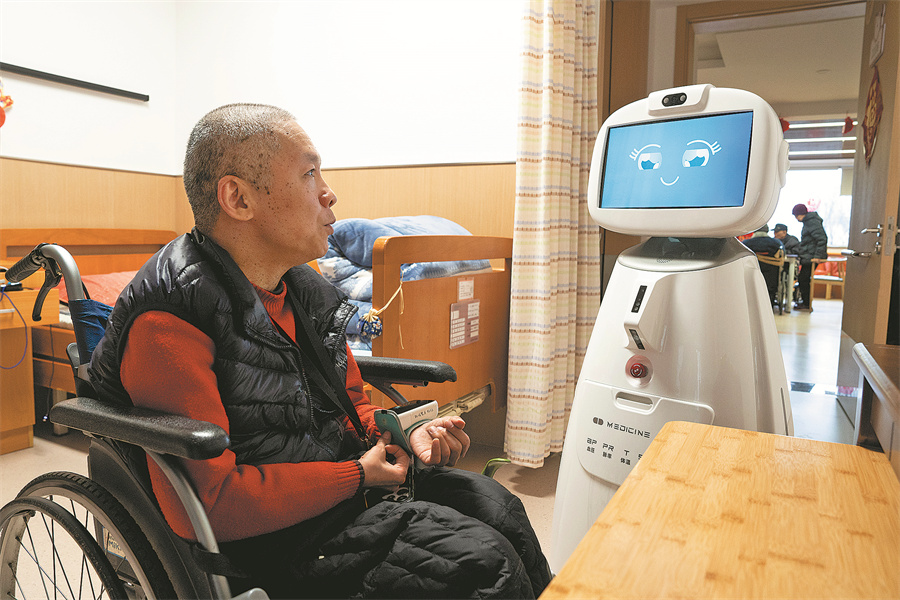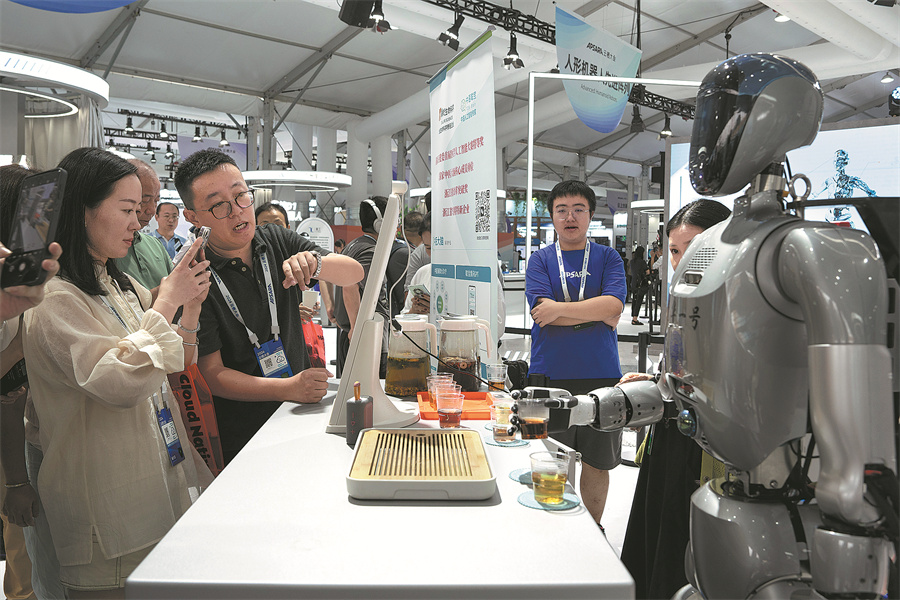Robots play growing role in elderly care

An elderly resident chats with a robot at a community center in Hangzhou last month. (Wu Junyi/China News Service)
SHENYANG — In a nursing home in South China's Shenzhen, an elderly resident curiously reaches out to hold the hand of Xia Lan, a humanoid robot with lifelike skin, blinking eyes, and a warm, soothing voice.
"Can you dance for us?" one senior asks, prompting smiles from those around. "I'm so happy to see robots becoming part of our lives," another resident remarks. "I hope they bring us more convenience."
China is witnessing a rapid integration of artificial intelligence and robotics into elderly care services, offering innovative solutions to the challenges of an aging population.
The latest data shows that by the end of last year, China's population aged 60 and above reached 310 million, accounting for roughly 22 percent of its total.
The International Electrotechnical Commission recently released a global standard for elderly care robots. Led by China in its formulation, the standard sets technical benchmarks for product design, manufacturing, testing and certification for such robots.
Elderly care robots, once a distant concept, are quickly becoming a reality for China's aging population.
"Elderly care robots represent an untapped market," said Bi Yalei, secretary-general of the Shenzhen Robots Association. "With pressing issues in senior care, such as mobility assistance, fall prevention, and rehabilitation support, many companies in Shenzhen are actively investing in this sector due to strong demand."
Although elderly care robots are still in their infancy compared to industrial robots, some users have already begun to experience the convenience they offer.
At Shenzhen Nursing Home, robots are now an integral part of daily life, playing chess with seniors, offering AI-assisted moxibustion therapy, and providing mobility assistance.
"We place great emphasis on the application of technology in elderly care," said Li Xipo, director of the nursing home. "By integrating AI robots, rehabilitation robots, and robotic pets, we aim to improve seniors' quality of life while creating a testing ground for industry innovation."
During this year's Spring Festival, Kenqing Technology, a Shenzhen-based robotics company, sparked online discussion when its exoskeleton robots assisted elderly users in climbing Taishan Mountain, one of the most iconic mountains in China.
"This experience revealed significant unmet needs among seniors," said Yu Yunbo, general manager of Kenqing Technology. "China's silver economy is vast, yet the market lacks high-quality elderly care products."
Across China, robotic solutions are transforming elderly care. In Shenyang, capital of Northeast China's Liaoning province, a 70-year-old stroke survivor surnamed Zhang has regained his ability to walk using an exoskeleton rehabilitation device developed by SIASUN Robot and Automation Co.
"At first, I could barely lift my leg. But now, I can climb stairs again," he said.
In Southwest China's Chengdu, Pacific Care Home has introduced a companion robot named Yang Yang, which wakes residents each morning, provides weather updates, and reminds them of their daily activities.
More humanoid elderly care robots like Yang Yang are set to enter the market. The Chengdu Humanoid Robot Innovation Center plans to launch a lightweight humanoid robot in June, designed specifically for family and wellness applications.
It will be able to identify seniors, bring them medicines, chat with them, and help them take showers. "Robots can bridge elderly care service gaps while fulfilling seniors' emotional needs," said Chen Yang, deputy general manager of the center.
Industry experts believe the rapid growth of the elderly care robot sector is being driven by policy support and the advancement of AI technology.
China's new guidelines for elderly care service reforms call for advancing humanoid robots, brain-computer interfaces, and AI technologies to enhance senior care.
"Robots are no longer just executors, they are evolving into AI-powered family members," said Zhang Yunquan, a researcher at the Institute of Computing Technology of the Chinese Academy of Sciences.
"Future robots will be able to detect emotional fluctuations, predict health risks, and provide proactive care just like an AI companion at home," Zhang said.
"Elderly care robots will ease home-based care challenges and unlock the potential of the silver economy. Moving forward, we must focus on technological breakthroughs, scenario adaptation, and ecosystem development to propel the industry's growth."

Visitors learn about a humanoid robot dedicated to elderly care during the 2024 Apsara Conference in Hangzhou, Zhejiang province, in September. (Wu Junyi/China News Service)
Photos
Related Stories
- Humanoid robots shine at 2025 Zhongguancun Forum
- Foreign experts laud the future of humanoid robots, confident of China’s robot industry growth prospects at Beijing forum
- Feature: Robotic fish help revitalize fish farming
- Chinese companies’ embracing open-source, close collaboration to greatly assist industry growth
- A close look at humanoid robot innovation center in Beijing
Copyright © 2025 People's Daily Online. All Rights Reserved.









